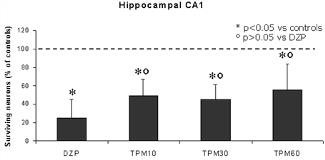TOPIRAMATE PROTECTS HIPPOCAMPAL LAYER CA1 IN THE LITHIUM-PILOCARPINE MODEL (LI-PILO) OF EPILEPSY BUT DOES NOT PREVENT EPILEPTOGENESIS
Abstract number :
1.280
Submission category :
Year :
2002
Submission ID :
1459
Source :
www.aesnet.org
Presentation date :
12/7/2002 12:00:00 AM
Published date :
Dec 1, 2002, 06:00 AM
Authors :
Marie A. Rigoulot, Estelle Koning, Arielle Ferrandon, Astrid Nehlig. Faculty of Medecine, INSERM U398, Strasbourg, France
RATIONALE: The Li-Pilo model reproduces the main characteristics of human temporal lobe epilepsy. After status epilepticus (SE), rats exhibit a [dsquote]silent[dsquote] seizure-free phase followed by a chronic phase during which spontaneous recurrent seizures (SRS) occur. Extensive damage is present in hippocampus, thalamus, amygdala and ventral cortices. The neuroprotective and antiepileptogenic effects of the anticonvulsant drug, topiramate (TPM) were investigated in this model.
METHODS: Adult Sprague-Dawley male rats were subjected to SE by injection of LiCl (3 meq/kg) followed 20 h later by Pilo (25 mg/kg). TPM at three doses (10, 30 or 60 mg/kg) was injected at 1 h and 10 h of SE. Thereafter injections were repeated twice a day for 6 days. Another group of animals received two injections of diazepam (DZP, 2.5 then 1.25 mg/kg) at 1 h and 10 h of SE and injections of vehicle for 6 days. Neuronal damage was assessed 14 days after SE by performing cell counting on thionine-stained sections. Occurrence of SRS was video-recorded for 10 h per day in a separate group of rats.
RESULTS: In DZP-treated rats, the number of neurons was dramatically reduced (54-100%) after SE in all subregions of hippocampus and layers II to IV of ventral cortices. At all doses, TPM induced a 24-30% neuroprotection in layer CA1 of hippocampus (p [lt]0.05). In CA3b, the 30 mg/kg dose reduced neuronal death by 100%. In DZP-exposed rats, Li-Pilo SE induced a 44-100% loss in piriform and ventral entorhinal cortex. No protection was afforded by TPM in these cortices. All rats subjected to SE became epileptic. TPM did not change the latency to SRS (16.4 days in DZP-treated vs 14-16.9 days in TPM-treated rats). The frequency of the SRS recorded over 4 weeks was increased by 2-fold in TPM30 compared to DZP rats but the difference was not significant probably because of the large interindividual variability.[figure1][figure2]
CONCLUSIONS: TPM displayed neuroprotective properties which were effective only in CA1 and CA3b possibly linked to specific sensitivity of pyramidal cell populations to the drug. The neuroprotection of CA1 by TPM was not efficient in preventing the occurrence of SRS, which confirms that this area is not critical in the process of epileptogenesis.
[Supported by: a grant from Johnson and Johnson Pharmaceutical Research and Development, LLC.]; (Disclosure: Grant - Supported by a grant from Johnson and Johnson Pharmaceutical Research and Development, LLC.)
